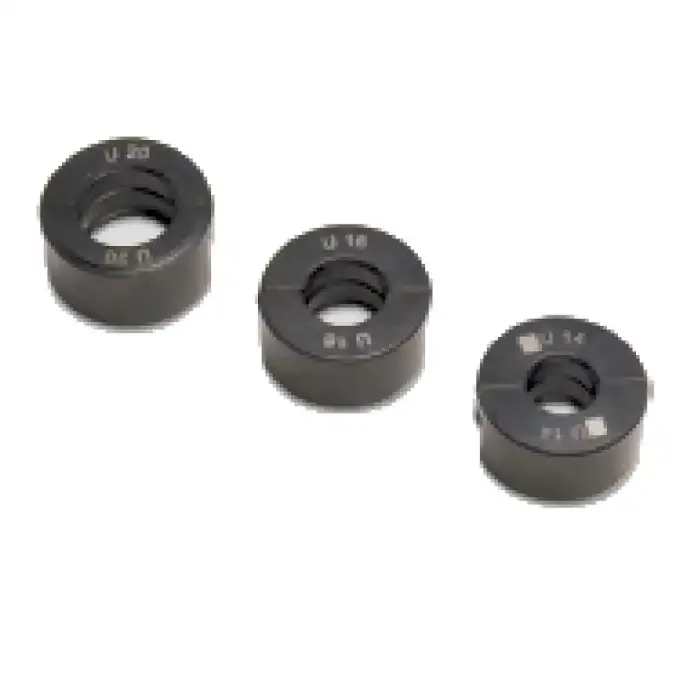If you work with press fittings, you will quickly encounter the abbreviations H, TH and U, which refer to press profiles — the geometries of press jaws or inserts that must match a fitting's contour exactly. It is crucial to get the profile right: only the correct combination of profile and fitting produces a durable, leak-free, standards-compliant joint.
TL;DR
- H profile: Common for many multilayer composite and plastic/metal composite systems (e.g. certain lines from Roth, Valsir, Aquatechnik and Prandelli).
- TH profile: A modified contour used by various systems (e.g. Wavin, Viega, Unipipe/Unicor, Henco, Brasstech, Bucchi, Comap Purmo, Sitec Press, Gabotherm Tiemme, Cobrapress Comisa lines).
- U profile: Typical for Uponor, Unicor Unipipe, Wavin Tigris and Coes systems + compatible lines.
Rule #1: Always follow the system manual. Using the wrong profile can result in leaks, loss of warranty and potential damage.
What is a press profile?
During pressing, the jaw plastically deforms the fitting and pipe in a controlled way. The profile geometry ensures that:
- the sealing area is compressed correctly
- a mechanical interlock is created for load transfer
- components are not overstressed.
H, TH and U are established contour families. They are not interchangeable. The fitting manufacturer specifies which profile is approved.
Typical mappings (examples)
Note: many brands offer several system lines. Do not rely on the brand name alone — use the exact system approval.

H
e.g. Roth, Valsir, Aquatechnik, Prandelli (line-dependent)
Multilayer composite (MLCP/AL-PEX), sometimes plastics

TH
e.g. Unipipe/Unicor, Wavin, some Viega lines
Multilayer composite

U
e.g. Uponor systems
Multilayer/plastic systems
This table is illustrative only. The installation manual for your system always takes precedence.
Find your correct profile in three steps
- Identify the system using the packaging, fitting stamp, ring colour and data sheet.
- Read the manual, which states the required press profile (e.g. 'Profile TH').
- Check the tool/jaw, the jaw (or insert) must carry the same profile. For modular hand presses, insert the matching profile insert.
Tip: many fittings have a stamp or colour code. Manufacturers also list approved diameters (e.g. 16/20/26 mm).
What happens if the wrong profile is used?
- Leaks under pressure/temperature cycling.
- Deformation or microcracks in fittings/pipes.
- Loss of warranty and documentation compliance.
- Rework and costly remediation.
H vs. TH vs. U – technical snapshot
- H: Contour with a specific pressure path for many composite systems. Widespread, but not universal.
- TH: A geometrically adjusted variant for certain fittings that avoids over/under-compression in those systems.
- U: A distinct contour that is widely used with Uponor and is tailored to their fitting design.
The differences involve radii, shoulder positions, flank angles and compression travel. Small changes determine where and by how much the seal is compressed.
Choosing tools and jaws
Working with one system?
Use a press tool (battery or manual) with jaws that match the profile (e.g. TH jaws measuring 16, 20 or 26 mm).
Working across multiple systems?
Manual presses with interchangeable inserts offer flexibility: one base tool with different profile (H/TH/U) and diameter (e.g. Ø14/16/18/20/26) inserts.
Benefits: saves cost and space — ideal for service vans.
Diameter planning
Common in HVAC/plumbing: Ø 14–26 mm for composite systems. Choose sets that cover your most commonly used sizes (e.g. 16/18/20/26 or 14/16/18/20/26).
Quality and safety checklist for tools
- Profile accuracy: precision-milled inserts and tight tolerances.
- Force path: sufficient stroke and even force transfer (manual presses should have a long stroke for good leverage).
- Materials: robust steel or aluminium, wear-resistant
- Maintenance: routine inspection and cleaning; calibration/verification in accordance with the manufacturer's schedule.
- Transport: A metal carry case protects the inserts and keeps the sets organised, reducing profile mix-ups on site.
- Documentation: mark profile, size and serial number. Consider taking photos after pressing for records.
Avoid these common mistakes
- 'It looks similar, so it must fit.' No — always check system approval.
- Using the wrong diameter (e.g. using 18 mm instead of 20 mm): verify the insert size before pressing.
- Poor pipe preparation: cut square, deburr, calibrate and mark the insertion depth.
- Incorrect insertion depth: use a depth mark and respect it; inspect after pressing.
- If lubrication is required for dry assembly, follow the manual — some systems specify assembly aids.
Pre-press checklist
🔲 Verify system line and profile (H/TH/U)
🔲 The diameter of the insert matches the fitting
🔲 The pipe is square-cut, deburred and calibrated
🔲 The depth mark is set and observed
🔲 The jaws and inserts are clean and undamaged
🔲 Press perpendicular to the pipe axis
🔲 A visual check of the press mark is performed after assembly
FAQ
Can I use H jaws to press TH fittings?
No, similar names do not necessarily mean compatibility. Only use the approved profile.
Are there 'universal' jaws?
In practice, no. 'Universal' usually refers to modular systems that allow you to quickly swap profile-specific inserts.
How do I identify the right profile in my kit?
Look for stamps or markings on the fittings or jaws, and check the manuals and colour codes. When in doubt, consult the datasheet or manufacturer support.
Which sizes are typical for residential work?
Often 16, 20 and 26 mm. Depending on the region or system, 14 and 18 mm may also be common.